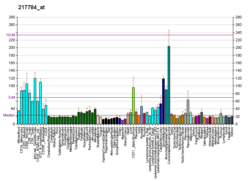YKT6
Synaptobrevin homolog YKT6 is a protein that in humans is encoded by the YKT6 gene.[5][6][7]
Function
This gene product is one of the SNARE recognition molecules implicated in vesicular transport between secretory compartments. It is a membrane associated, isoprenylated protein that functions at the endoplasmic reticulum-Golgi transport step. This protein is highly conserved from yeast to human and can functionally complement the loss of the yeast homolog in the yeast secretory pathway.[7]
Interactions
References
- 1 2 3 GRCh38: Ensembl release 89: ENSG00000106636 - Ensembl, May 2017
- 1 2 3 GRCm38: Ensembl release 89: ENSMUSG00000002741 - Ensembl, May 2017
- ↑ "Human PubMed Reference:".
- ↑ "Mouse PubMed Reference:".
- ↑ Veit M (Dec 2004). "The human SNARE protein Ykt6 mediates its own palmitoylation at C-terminal cysteine residues". The Biochemical Journal. 384 (Pt 2): 233–7. doi:10.1042/BJ20041474. PMC 1134105. PMID 15479160.
- ↑ Rossi V, Banfield DK, Vacca M, Dietrich LE, Ungermann C, D'Esposito M, Galli T, Filippini F (Dec 2004). "Longins and their longin domains: regulated SNAREs and multifunctional SNARE regulators". Trends in Biochemical Sciences. 29 (12): 682–8. doi:10.1016/j.tibs.2004.10.002. PMID 15544955.
- 1 2 "Entrez Gene: YKT6 YKT6 v-SNARE homolog (S. cerevisiae)".
- ↑ Shorter J, Beard MB, Seemann J, Dirac-Svejstrup AB, Warren G (Apr 2002). "Sequential tethering of Golgins and catalysis of SNAREpin assembly by the vesicle-tethering protein p115". The Journal of Cell Biology. 157 (1): 45–62. doi:10.1083/jcb.200112127. PMC 2173270. PMID 11927603.
- ↑ Xu Y, Martin S, James DE, Hong W (Oct 2002). "GS15 forms a SNARE complex with syntaxin 5, GS28, and Ykt6 and is implicated in traffic in the early cisternae of the Golgi apparatus". Molecular Biology of the Cell. 13 (10): 3493–507. doi:10.1091/mbc.E02-01-0004. PMC 129961. PMID 12388752.
Further reading
- Maruyama K, Sugano S (Jan 1994). "Oligo-capping: a simple method to replace the cap structure of eukaryotic mRNAs with oligoribonucleotides". Gene. 138 (1–2): 171–4. doi:10.1016/0378-1119(94)90802-8. PMID 8125298.
- McNew JA, Sogaard M, Lampen NM, Machida S, Ye RR, Lacomis L, Tempst P, Rothman JE, Söllner TH (Jul 1997). "Ykt6p, a prenylated SNARE essential for endoplasmic reticulum-Golgi transport". The Journal of Biological Chemistry. 272 (28): 17776–83. doi:10.1074/jbc.272.28.17776. PMID 9211930.
- Suzuki Y, Yoshitomo-Nakagawa K, Maruyama K, Suyama A, Sugano S (Oct 1997). "Construction and characterization of a full length-enriched and a 5'-end-enriched cDNA library". Gene. 200 (1–2): 149–56. doi:10.1016/S0378-1119(97)00411-3. PMID 9373149.
- Tochio H, Tsui MM, Banfield DK, Zhang M (Jul 2001). "An autoinhibitory mechanism for nonsyntaxin SNARE proteins revealed by the structure of Ykt6p". Science. 293 (5530): 698–702. doi:10.1126/science.1062950. PMID 11474112.
- Honer WG, Falkai P, Bayer TA, Xie J, Hu L, Li HY, Arango V, Mann JJ, Dwork AJ, Trimble WS (Apr 2002). "Abnormalities of SNARE mechanism proteins in anterior frontal cortex in severe mental illness". Cerebral Cortex. 12 (4): 349–56. doi:10.1093/cercor/12.4.349. PMID 11884350.
- Shorter J, Beard MB, Seemann J, Dirac-Svejstrup AB, Warren G (Apr 2002). "Sequential tethering of Golgins and catalysis of SNAREpin assembly by the vesicle-tethering protein p115". The Journal of Cell Biology. 157 (1): 45–62. doi:10.1083/jcb.200112127. PMC 2173270. PMID 11927603.
- Xu Y, Martin S, James DE, Hong W (Oct 2002). "GS15 forms a SNARE complex with syntaxin 5, GS28, and Ykt6 and is implicated in traffic in the early cisternae of the Golgi apparatus". Molecular Biology of the Cell. 13 (10): 3493–507. doi:10.1091/mbc.E02-01-0004. PMC 129961. PMID 12388752.
- Puri N, Kruhlak MJ, Whiteheart SW, Roche PA (Nov 2003). "Mast cell degranulation requires N-ethylmaleimide-sensitive factor-mediated SNARE disassembly". Journal of Immunology. 171 (10): 5345–52. doi:10.4049/jimmunol.171.10.5345. PMID 14607937.
- Fukasawa M, Varlamov O, Eng WS, Söllner TH, Rothman JE (Apr 2004). "Localization and activity of the SNARE Ykt6 determined by its regulatory domain and palmitoylation". Proceedings of the National Academy of Sciences of the United States of America. 101 (14): 4815–20. doi:10.1073/pnas.0401183101. PMC 387331. PMID 15044687.
- Tai G, Lu L, Wang TL, Tang BL, Goud B, Johannes L, Hong W (Sep 2004). "Participation of the syntaxin 5/Ykt6/GS28/GS15 SNARE complex in transport from the early/recycling endosome to the trans-Golgi network". Molecular Biology of the Cell. 15 (9): 4011–22. doi:10.1091/mbc.E03-12-0876. PMC 515336. PMID 15215310.
- Kimura K, Wakamatsu A, Suzuki Y, Ota T, Nishikawa T, Yamashita R, Yamamoto J, Sekine M, Tsuritani K, Wakaguri H, Ishii S, Sugiyama T, Saito K, Isono Y, Irie R, Kushida N, Yoneyama T, Otsuka R, Kanda K, Yokoi T, Kondo H, Wagatsuma M, Murakawa K, Ishida S, Ishibashi T, Takahashi-Fujii A, Tanase T, Nagai K, Kikuchi H, Nakai K, Isogai T, Sugano S (Jan 2006). "Diversification of transcriptional modulation: large-scale identification and characterization of putative alternative promoters of human genes". Genome Research. 16 (1): 55–65. doi:10.1101/gr.4039406. PMC 1356129. PMID 16344560.
- Okumura AJ, Hatsuzawa K, Tamura T, Nagaya H, Saeki K, Okumura F, Nagao K, Nishikawa M, Yoshimura A, Wada I (Feb 2006). "Involvement of a novel Q-SNARE, D12, in quality control of the endomembrane system". The Journal of Biological Chemistry. 281 (7): 4495–506. doi:10.1074/jbc.M509715200. PMID 16354670.
- Ooe A, Kato K, Noguchi S (Mar 2007). "Possible involvement of CCT5, RGS3, and YKT6 genes up-regulated in p53-mutated tumors in resistance to docetaxel in human breast cancers". Breast Cancer Research and Treatment. 101 (3): 305–15. doi:10.1007/s10549-006-9293-x. PMID 16821082.
This article is issued from
Wikipedia.
The text is licensed under Creative Commons - Attribution - Sharealike.
Additional terms may apply for the media files.





